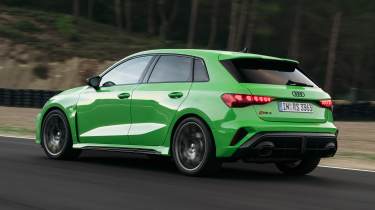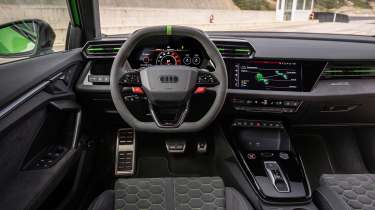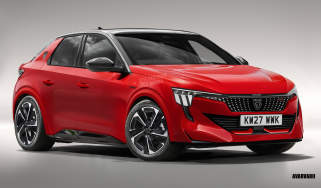New Audi RS 3 2024 review: is there a new hyper-hatch king?
The Audi RS 3 renews hostilities with the Mercedes-AMG A 45, but this time it might just have the edge

Verdict
The Audi RS 3 has been locked in a battle for hyper-hatch supremacy with the Mercedes-AMG A 45 for years, but the latest changes - in particular those to the RS 3’s Sport differential - feel like they have swung momentum in Audi’s favour. At its limits the RS 3 now runs the latest A 45 incredibly close for sharpness and precision, yet it maintains the superior refinement - not to mention its wonderful five-cylinder engine - that have been the RS 3’s advantages in recent years. We can’t wait to see how the pair compare back-to-back on UK roads, because it’ll be one almighty scrap.
Five seconds is a long time on a racetrack, even on a circuit that takes in 154 turns in the course of its 12.9 miles. So it makes the achievement of the new Audi RS 3, which has beaten its predecessor by that margin around the Nürburgring Nordschleife, really quite something.
With a lap time of seven minutes, 33.123 seconds, the Audi is now the quickest car in its class around the Green Hell. And with the track conditions, weather, and the driver (Audi’s own GT3 racer Frank Stippler) the same for both runs, and considering how minor the changes seem at first glance, a five-second improvement over the old model becomes all the more intriguing.
More reviews
But before we come onto those technical changes, it’s the cosmetic tweaks to Audi’s hyper-hatch that are most obvious. The RS 3’s singleframe front grille has grown flatter and wider than before, now extending into some even more dramatic intakes to either side. The tweaked bumper consists of a splitter that extends in one smooth span across the lower edge rather than the slightly stepped version of the old car - a change that is said to make a subtle nod to the quattro S1 Pikes Peak.
The LED headlight graphics have been adjusted, too, with 24 individual and customisable elements in the daytime running lights. Around the back, a single vertical reflector sits within the diffuser, while a second pair sits at the outer edges of the bumper to ape the vertical air intakes at the front. There are new colours and wheels, too, with the 19-inch intricate cross-spoke design previously reserved for the limited-edition RS 3 Performance now fitted to Black Edition and Vorsprung models - the two trim levels which sit above the standard RS 3.
Inside, the key change comes with a new steering wheel. It’s flattened both on the top and the bottom, and this functional change comes with a set of shortcut keys for the drive modes. The old physical buttons on the spokes have gone, changed for a pair of sometimes touch-sensitive, sometimes haptic switches that are prone to being accidentally engaged with a stray brush of the hand. Whether you like the look of the new rim more than the old one will come down to personal taste, but the previous design was less fiddly to use.
A more positive introduction is that UK buyers can now opt for the RS carbon fibre-backed bucket seats. We’d go for them every time; they look great and offer plenty of comfort, yet also hold the driver and front passengers much more firmly through turns - a simple change that allows those who choose them to feel so much more connected to the action. They’re available on every trim level: a £2,500 option on RS 3 and Carbon Black trims, and a £2,000 add-on for the top spec Vorsprung.
Onto that lap time then. And first off, the extra performance hasn’t come from the most obvious source; as before, Audi’s signature five-cylinder, 2.5-litre turbocharged engine makes 395bhp and 500Nm of torque, which is sent to all four wheels. The 0-62mph benchmark sprint remains the same at just 3.8 seconds.
It’s still a fantastic motor. Even though emissions-busting particulate filters have gradually taken the raw edge off the noise (a step mitigated this time by Audi’s choice to open the exhaust valves sooner to make a touch more sound), that five-cylinder tone remains the RS 3’s most joyful USP – a reason on its own to choose the Audi above its key rival from Mercedes-AMG, the A 45.
The power delivery is strong and relentless, to the point where it feels like it could easily handle a few more revs. Engage manual mode for the seven-speed dual clutch transmission, and we can excuse you for inadvertently butting into the rev limiter, given how strongly the engine still pulls right at its red line.
Rather than focussing on the engine, Audi’s engineers have extracted lap time from the chassis - specifically with the way that some of the very clever electronic systems talk to one another. Quicker algorithms within the Brake Torque Splutter and the Torque Vectoring systems help the two brains communicate more rapidly and in more detail than before. The result is that the front end is less resistant to understeer, which brings the knock-on benefits of enabling the driver to carry a little more speed at the apex while also jumping on the throttle sooner, firing the car along the next straight at an even greater speed.
We were given the chance to test those tweaks to the extreme around the ParcMotor Circuit Castellolí near Barcelona. Whether leaning on the front tyres through that track’s, quicker, more sustained corners, or braking hard into one of its tight hairpins, the nose is noticeably more keen to dive towards an apex than before, but it does so without any flighty feeling from the rear axle.
The steering is precise and the brakes are strong - though sustained use on track did introduce a soft left pedal a little quicker than we had anticipated. That aside, the car’s pace is staggering, with great agility, stability and overall limits of traction and grip. It’s not only devastatingly quick, but there’s also enough scope to adjust the balance with your own steering and pedal inputs for it to feel like the driver is making the difference.
Our one small gripe is that, as before, the Sport differential has been optimised for a very sticky set of Pirelli Trofeo R tyres - an option that isn’t offered to UK buyers. However, the good news for us is that the standard, more road-biassed tyres - whether they're Bridgestone or Pirelli - have both been upgraded. Our road routes used these improved Pirellis, and even at more sensible speeds, the RS 3’s grip, poise and balance are remarkable. That it comes closer than ever to the A 45’s sharpness while being the easier car to live with every day is its most impressive achievement.
The revised RS 3 is available to order now, with first UK deliveries due in January. The range kicks off from £59,510, climbing to £68,650 for the Vorsprung, which among other upgrades gets a panoramic roof and a top speed that’s increased from 155mph to 174mph. As before, the RS 3 can still be ordered in saloon form, which like-for-like costs £1,000 more than the Sportback.
| Model: | Audi RS 3 Sportback Carbon Vorsprung |
| Price: | £68,650 |
| Powertrain: | 2.5-litre 5-cylinder petrol |
| Power/torque: | 395bhp/500Nm |
| Transmission: | Seven-speed auto, four-wheel drive |
| 0-62mph: | 3.8 seconds |
| Top speed: | 174 mph |
| Economy/CO2: | 30.7mpg/209g/km |
| Size (L/W/H): | 4,381/1,851/1,418mm |
| On sale: | Now |










